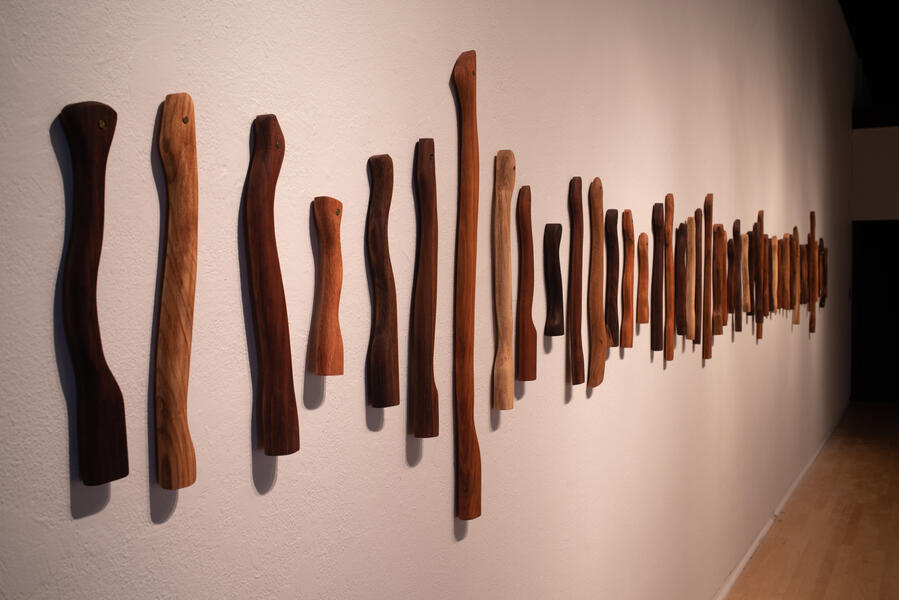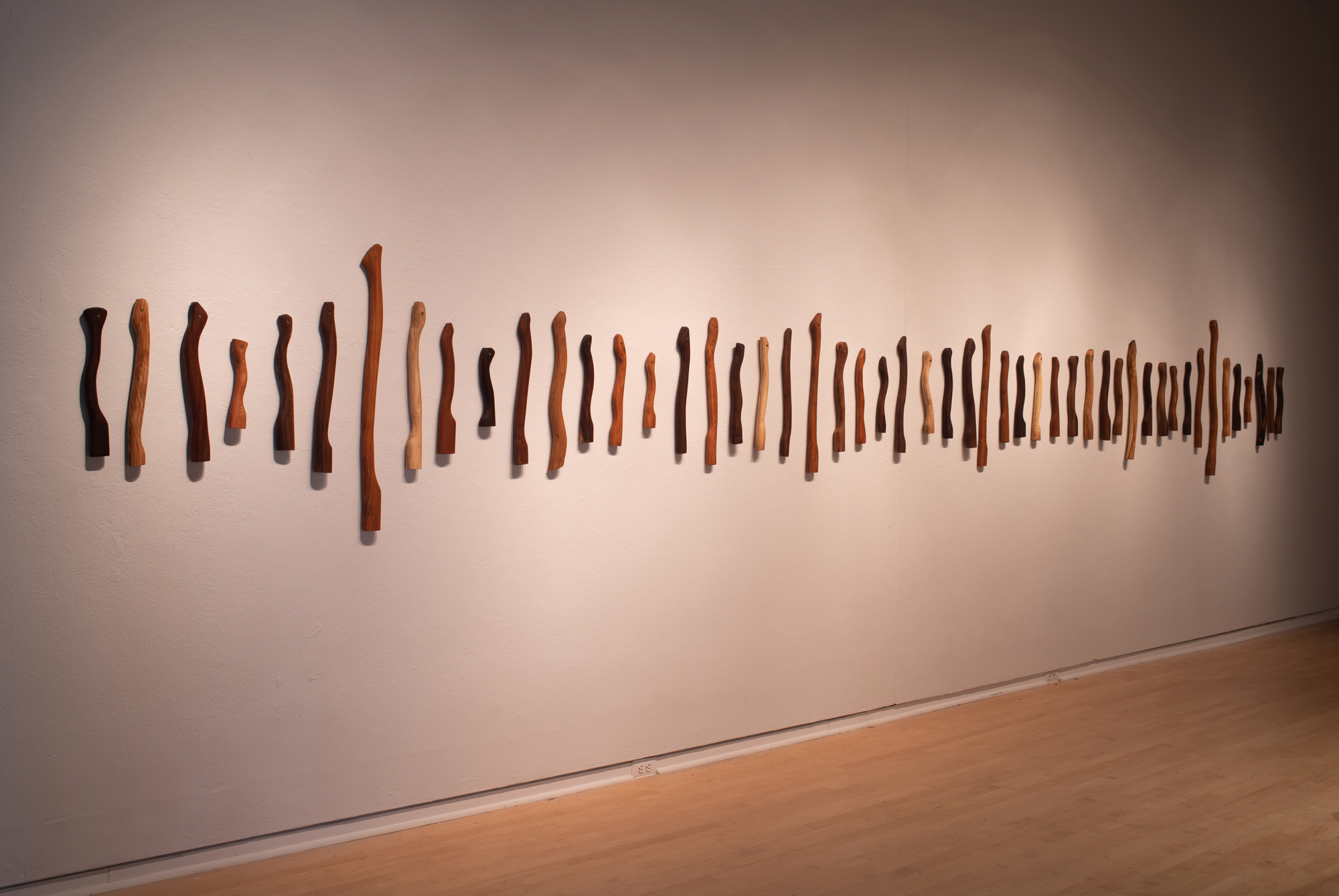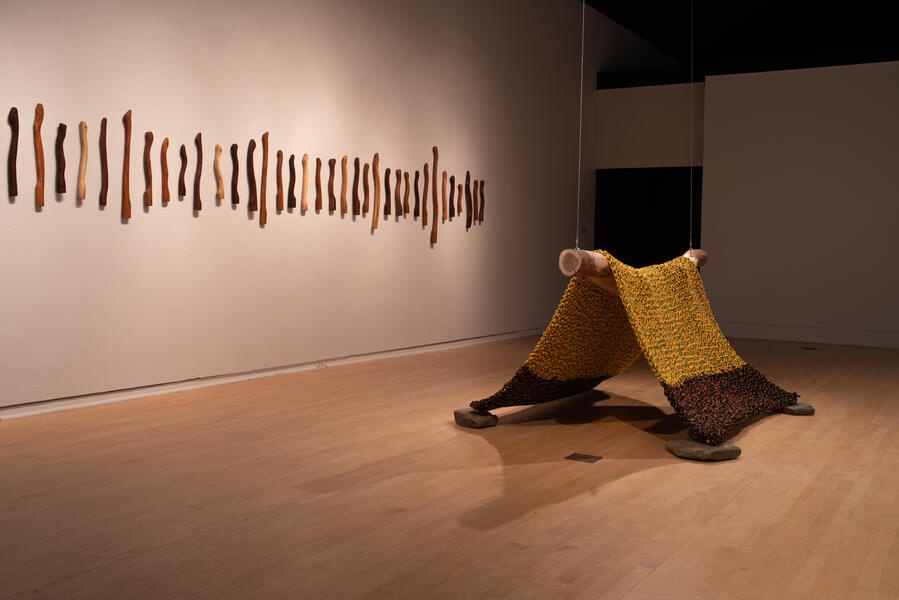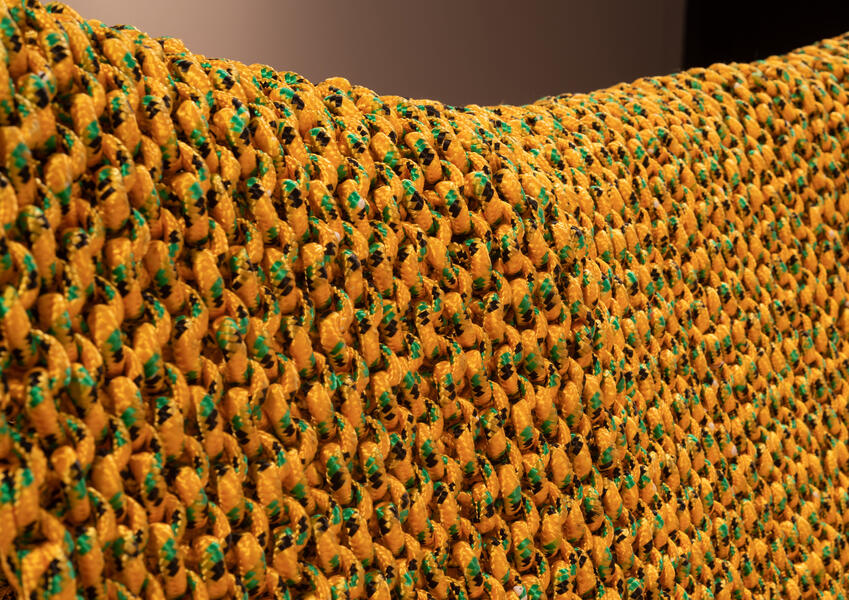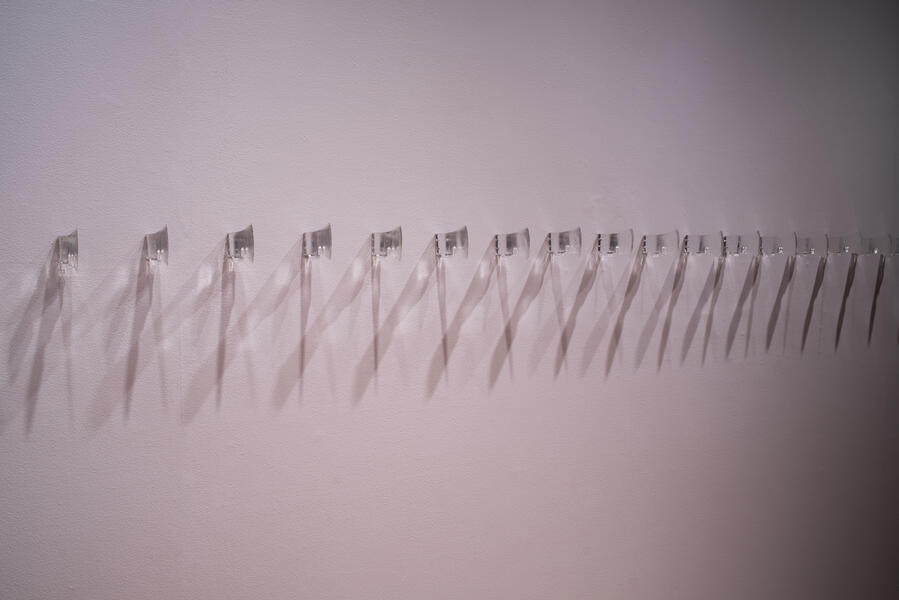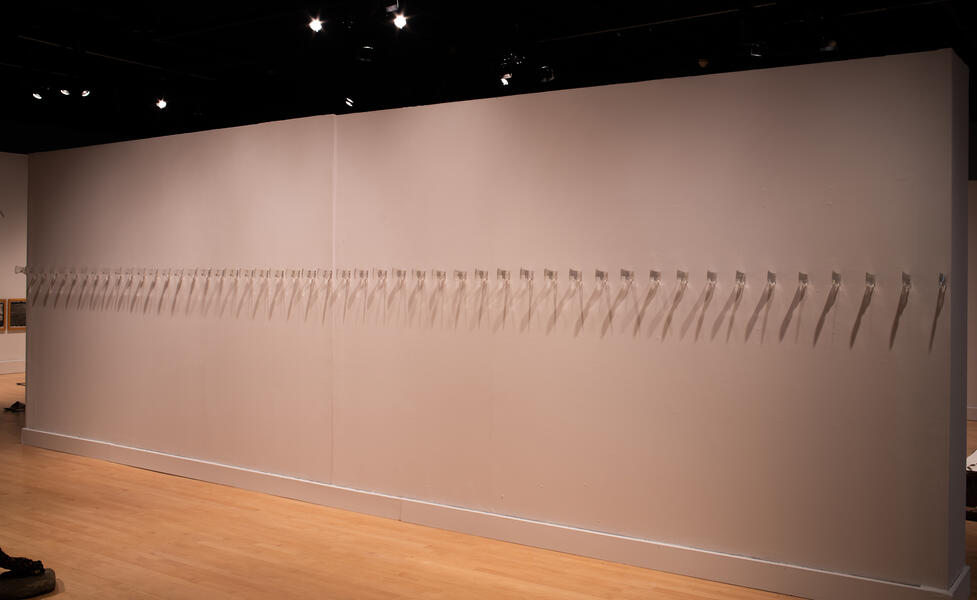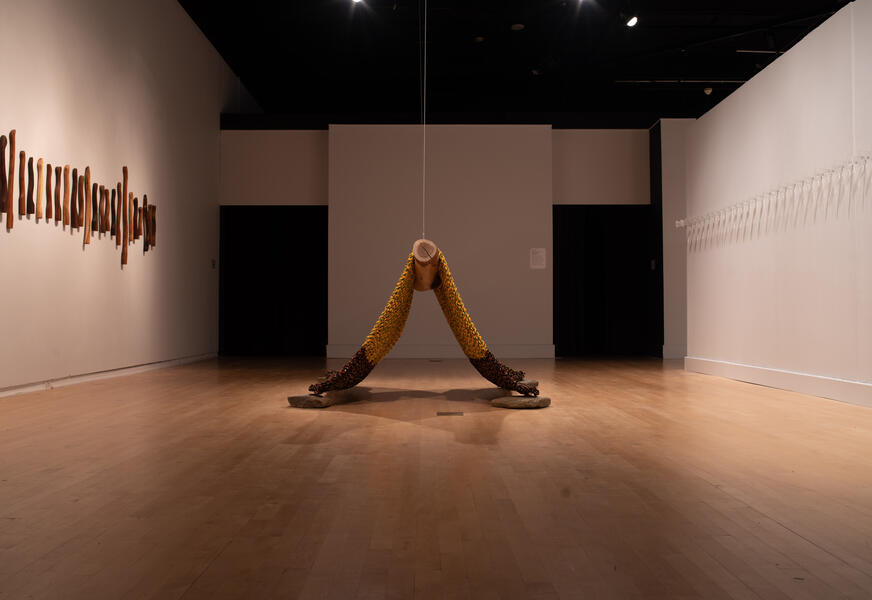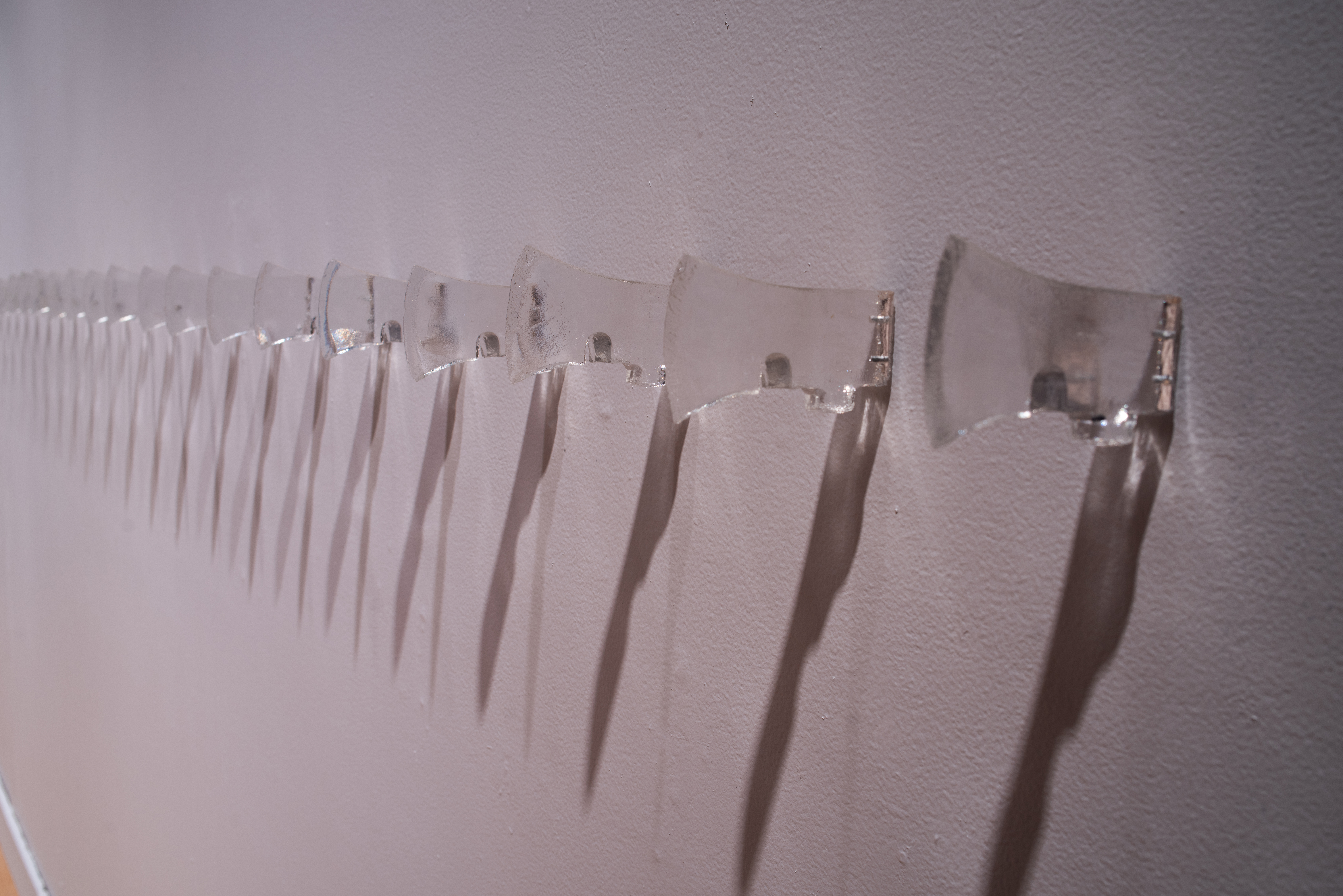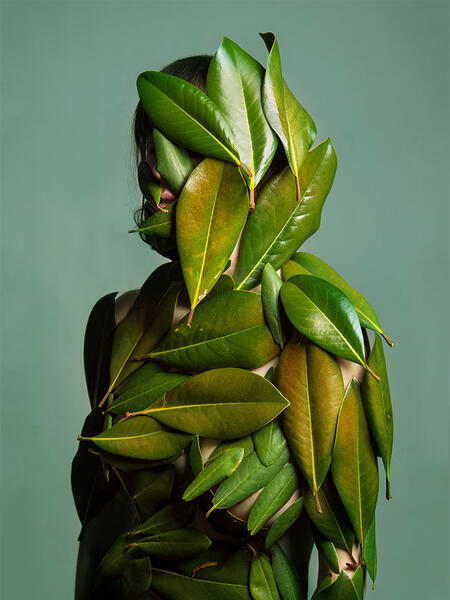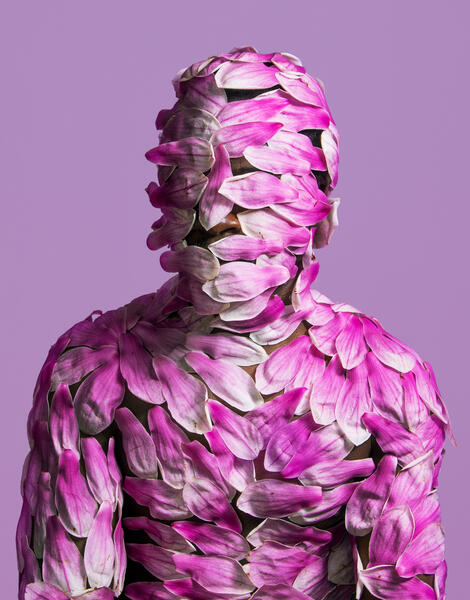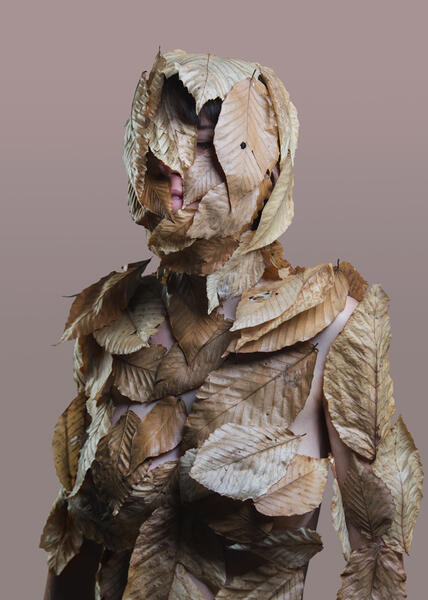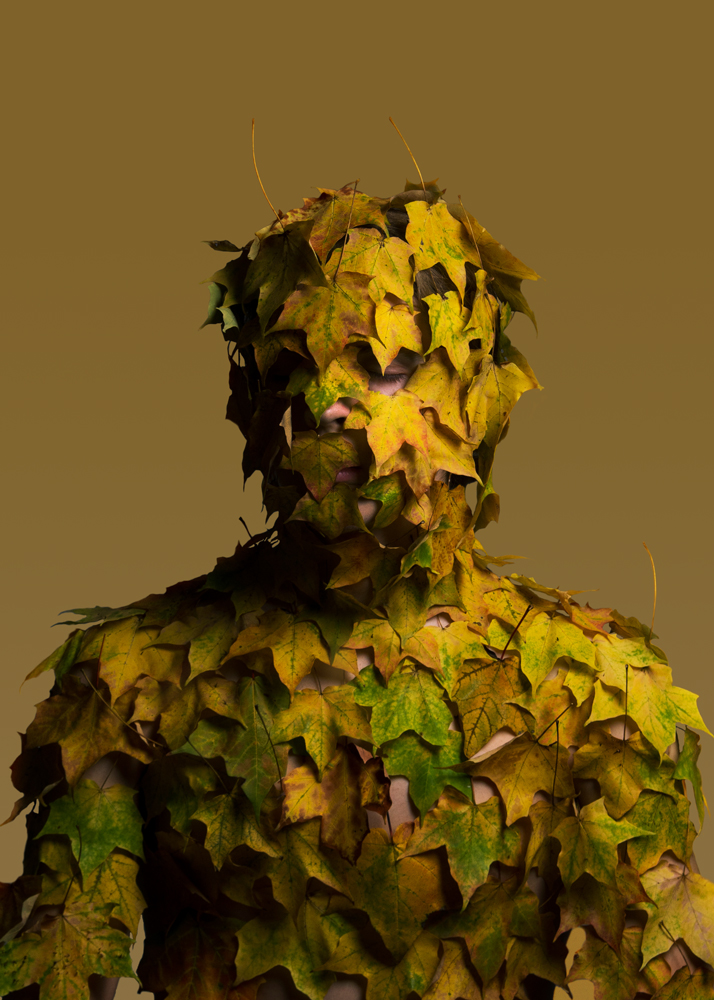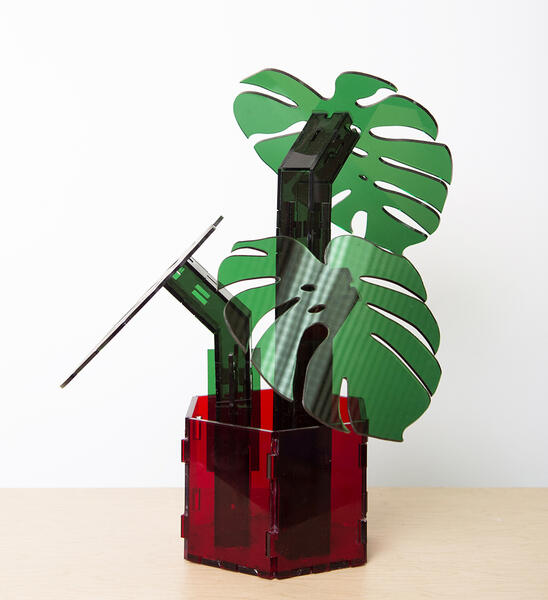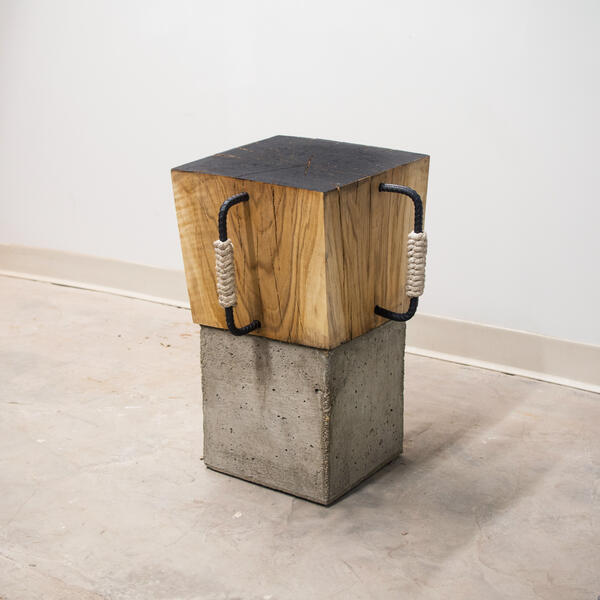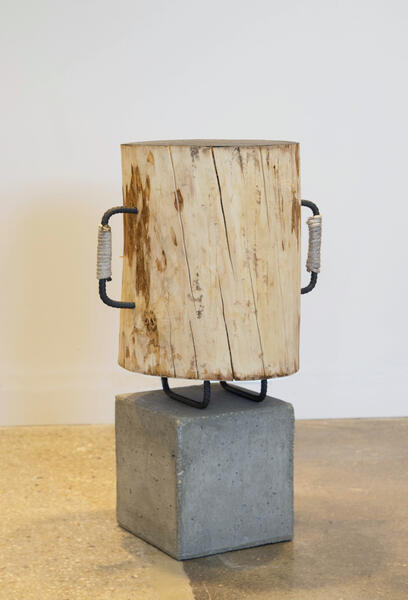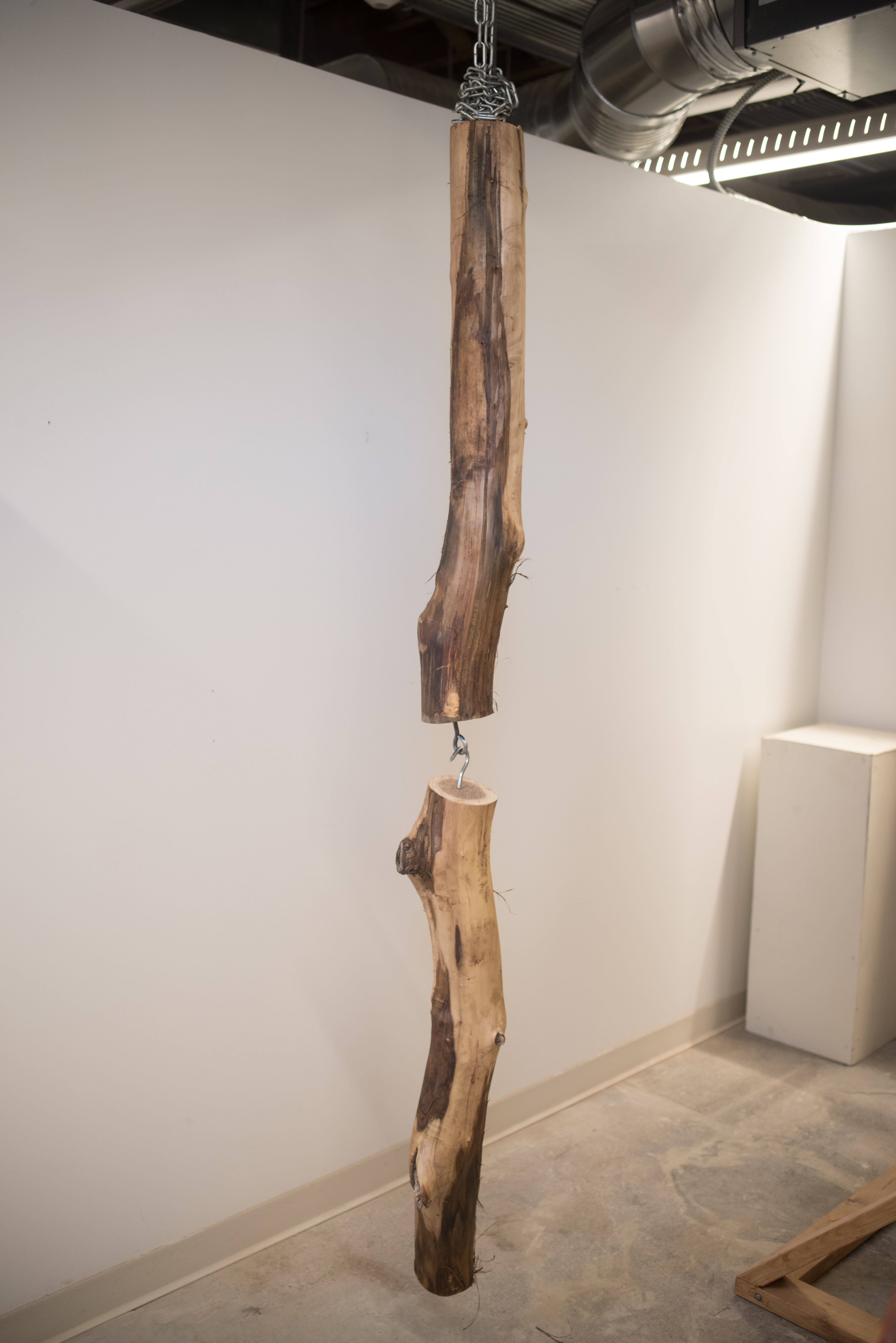About Bryan
Baltimore City
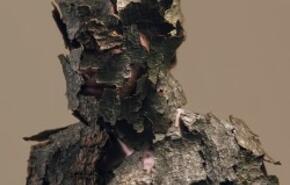
I think of my work as a continuum. Projects and series are almost never truly finished, but evolve into the next iteration of themselves, resulting in contiguous pieces that are all related and allude to the same overarching concepts with varied focuses. The result of this continuous retooling and lucubration means my work becomes increasingly expert, leading to a familiarity, that in turn drives variation and evolution.
Much of my work is based on repetition. I gravitate… more
Much of my work is based on repetition. I gravitate… more
Jump to a project:
Axe Handles
A work in progress. This installation will consist of 50 hanging axe handles. Each handle has been hand-carved using a combination of hatchet, saw, knife, and sandpaper. Each finished handle holds within it hours of meditative effort in which the calming comfort of repetitive action culminates in a perfectly smooth and beautiful object. Within this beauty lies a certain violence, as the elegant curves of the handle serve only one purpose: to swing. Bereft of their heads, the axe handles pose no threat to the trees from which they are born. If trees are the supreme symbol of nature, then the axe is the antithesis of the tree, and in turn the antithesis of nature. Yet the axe is also a modern symbol of the outdoorsman. Due to its long history as the foremost tool in the clearing of American land, it is symbolically on par with the cut stump. In Ravages of the Axe: The Meaning of the Tree Stump in Nineteenth Century American Art, Nikolai Cikozsky Jr. states:
"The urgent need to clear land for immediate cultivation and habitation vastly outweighed considerations of beauty and made destruction of forests inevitable. The urgency was so great, and the obstacles so many, that Americans looked upon trees as their enemies, took positive pleasure in destroying them, and were not content until they had denuded the land. "
This means, then, that in American landscape painting, the cut stump is a symbol of progress and human reslience over nature. It follows that the axe also held this symbolic weight. Whereas our societal perceptions of the cut stump have generally shifted – a clear-cut forest is mainly regarded negatively – the axe or hatchet remains a symbol of outdoorsmanship . My work explores outdoorsmanship’s place in modern America as I attempt to deconstruct and understand the mindset of the modern outdoorsman, both within myself and in American society.
"The urgent need to clear land for immediate cultivation and habitation vastly outweighed considerations of beauty and made destruction of forests inevitable. The urgency was so great, and the obstacles so many, that Americans looked upon trees as their enemies, took positive pleasure in destroying them, and were not content until they had denuded the land. "
This means, then, that in American landscape painting, the cut stump is a symbol of progress and human reslience over nature. It follows that the axe also held this symbolic weight. Whereas our societal perceptions of the cut stump have generally shifted – a clear-cut forest is mainly regarded negatively – the axe or hatchet remains a symbol of outdoorsmanship . My work explores outdoorsmanship’s place in modern America as I attempt to deconstruct and understand the mindset of the modern outdoorsman, both within myself and in American society.
Shelter
In studying survivalists, I became preoccupied with certain tools and materials that hold a prominent place in the bushcrafter’s toolkit. Foremost among these is paracord. This durable nylon material has, in some ways, become a symbol of survival. Thousands of tutorials exist, providing instructions in the many applications of lanyard tying, handle wrapping, and so forth. From my time in the Boy Scouts I was taught that knot tying was an essential skill for any man; therefore, a great emphasis was placed on always being prepared with a good length of rope and the knowledge to use it. To me, with its prominent symbolic and practical status within survivalist and outdoor culture, paracord already feels like a masculine material. When one considers its origins as a military tool, this feeling is solidified.
In order to subvert the masculine nature of the material, I decided to give it new purpose within the context of a traditionally feminine skill: knitting. Several years before I started this project, I learned to knit as a way to relieve anxiety associated with severe health problems my father was experiencing. Just like the carving of axe handles, the comfort of knitting comes from the repetitive pattern of motion. Knitting stands in contrast to the forceful swings of the hatchet, where each blow sends shockwaves through the body and the shear physicality of the process leads to a mind-numbing involvement. The much more subtle and precise movements of the knitting needles evoke a peacefulness. The mind is focused on the task at hand, yet it is also free to wander and produce deeper thoughts and entanglements.
In a previous piece, Lanyard(2017), I played with the idea of a paracord potholder and/or dishtowel. Inspired by the many YouTube lanyard tutorials, I created a survivalist’s potholder, handily attached to the back of a pocketknife. This arguably useless object, composed of over 100 feet of life-saving paracord, acted as an introduction to the material and the process, while marking the beginning of my exploration into stereotypical gender roles. In this piece, I point out inconsistencies between masculine bushcrafters teaching the viewer to weave paracord lanyards for their collection of large knives, but balking at the idea of knitting. For example, in a video by “TheGroverx,” he goes through the process of crocheting a paracord backpack, some choice phrases from the comments section included, “awesome, gonna have to get my wife to do this for me” and “tactical gayness.” There was also a general consensus that the activity is indeed manly, strictly because the crocheting was done with paracord and not yarn.
Axe Heads
While the axe handle holds a certain affinity with the tree, the axe head is a violent stranger. With the cutting force to implement the tree’s downfall, the axe head symbolizes mankind’s dominance over nature, not only in its use, but in its physical composition. While the handle is just a piece of dead wood, shaped for use but with the wood’s underlying cell structure unchanged, the metal head represents another step in mankind’s continued advancement of materials. Both iron, which has existed far longer than humans, and steel, which has existed since ancient times when iron was alloyed with carbon, are materials we unremittingly reclaim and reshape into products.
Using polyester resin, I cast the 50 axe head blades displayed on the wall directly opposite the wooden axe handles. The process of creating these blades stands in contrast to the other work in my exhibition. Repetition remains a vital component, but the actual creation involves almost no physical labor. Instead, there is only a repeated mixing and pouring of resin. To me, this difference in process is significant since it relates to the entirely different material used to make the axe heads. The viscously flowing resin cannot be formed by hand; it needs a silicone mold to hold its shape until it can set in its solid form. The polyester resin axe heads thus create an even sharper contrast with the wooden axe handles hanging directly opposite them than would if they were made of iron or steel. Like steel, this resin is a synthetic amalgamation of many organic compounds, chemically combined to form a new substance that would otherwise not occur naturally.
Using polyester resin, I cast the 50 axe head blades displayed on the wall directly opposite the wooden axe handles. The process of creating these blades stands in contrast to the other work in my exhibition. Repetition remains a vital component, but the actual creation involves almost no physical labor. Instead, there is only a repeated mixing and pouring of resin. To me, this difference in process is significant since it relates to the entirely different material used to make the axe heads. The viscously flowing resin cannot be formed by hand; it needs a silicone mold to hold its shape until it can set in its solid form. The polyester resin axe heads thus create an even sharper contrast with the wooden axe handles hanging directly opposite them than would if they were made of iron or steel. Like steel, this resin is a synthetic amalgamation of many organic compounds, chemically combined to form a new substance that would otherwise not occur naturally.
Flora
“We come from the earth and to the earth we must return”
As a human, there is a tendency to consider oneself separate from nature. A different force completely, with the divine right to use and consume all that which nature provides. We forget our place in the earths ecosystem as well envelop ourselves in manufactured surroundings to shield us from the harsh and savage realities, as well as the beautiful tranquility of the natural environment. However we are not completely lost, many of us want to restore that connection our species once had with the flora and fauna of the Earth. So we go about our days trying to help in some small ways. We recycle – despite its inefficiency we feel better about ourselves. We bike to work – amidst swarms of vehicles pouring out exhaust. We make these personal and surface level changes that momentarily pacify our guilt but are still dogged by the looming and crushing presence of industry and global pollution.
As a human, there is a tendency to consider oneself separate from nature. A different force completely, with the divine right to use and consume all that which nature provides. We forget our place in the earths ecosystem as well envelop ourselves in manufactured surroundings to shield us from the harsh and savage realities, as well as the beautiful tranquility of the natural environment. However we are not completely lost, many of us want to restore that connection our species once had with the flora and fauna of the Earth. So we go about our days trying to help in some small ways. We recycle – despite its inefficiency we feel better about ourselves. We bike to work – amidst swarms of vehicles pouring out exhaust. We make these personal and surface level changes that momentarily pacify our guilt but are still dogged by the looming and crushing presence of industry and global pollution.
Vector-Based Houseplants
In light of recent political events these Vector-Based houseplants become increasingly sinister. Working with digital software and a laser-cutter I have created fully modular, acrylic houseplants with the ability to grow at the owners will. The mechanization and petroleum-based material reflects the disturbing neglect our society inflicts on our natural world. Symbolizing our ever increasing move away from our natural surroundings into our manufactured ones, they warn of an eerie dystopian future, devoid of plant life.
Untitled(Printing)
The concept of Nature as harsh and eternal is prevalent throughout the history of America. Frontiersmen viewed the wilderness as a separate entity to be conquered. In The Ravages of the Axe Nicolai Cikovsky Jr. writes how Billy Kirby, James Fenimore Cooper's woodsman in The Pioneers, held trees to be "a sore sight at any time, unless I'm privileged to work my will on them.” In current times the rugged male individualist heads “into the wild” to eat poison berries, starve, and die. In my sculptures I explore several concepts, one being masculine nature. Logs, once living organisms, lay flayed and dejected. Stripped of their bark they cease to exist as they once did, symbols of strength and resilience, and become grotesque and vulnerable extremities. They are shaped to fit my needs and become my printmaking tools.
William Lamson’s Action for the Delaware begins with Lamson standing majestically upon the Delaware River. His Christ-like poise is soon interrupted with shots of him struggling to maintain his position above the water; much splashing ensues. In my printing performances the absurdity of my struggle to effectively use my cumbersome tools betrays the toxic masculinity of the sculptures.
William Lamson’s Action for the Delaware begins with Lamson standing majestically upon the Delaware River. His Christ-like poise is soon interrupted with shots of him struggling to maintain his position above the water; much splashing ensues. In my printing performances the absurdity of my struggle to effectively use my cumbersome tools betrays the toxic masculinity of the sculptures.
Mesh
When considering the earth, humans tend to consider themselves apart; as separate beings given divine rights over all that is “natural.” We manufacture our surroundings and envelop our bodies in a shield of the synthetic. This way of thinking is sinister and has been a continual justification for the damages we have inflicted upon the world. It is not necessarily that humans hate Nature, rather we idealize it as a resilient concept; eternal and harsh. I work to explore our true connection to all that surrounds us, bridging that disconnect to experience the amorphous blob that is the mesh. The concept of the mesh is to see the reality of the way things truly are in the world: interconnected and amorphous.
Within our atmosphere there is no truly empty space, everything blurs into everything else. Holding an object one can perceive where that object ends and one’s hand begins, but atomically there is simply a constant continuum. Human is nature. Trees are nature. Plastic is nature? Well yes in the end everything derives from nature. Compartmentalizing natural and synthetic into their own untouchable realms creates a disconnect that inevitably leads to harmful behavior on a global scale. Think interconnectedness, think amorphously.
In my video installation I create nebulous blobs of organic material. My performance of merging with these materials via video becomes an act of contemplation and intimacy. Watching these videos one can imagine the complex conflicting sensations of discomfort and calming meditation. For this project I drew inspiration from Robert Wilson’s Video Portrait of Lady Gaga as well as Eija-Liisa Ahtila’s Horizontal . The slow rhythm of these two videos grounds the viewer and holds them captivated and contemplative.
Within our atmosphere there is no truly empty space, everything blurs into everything else. Holding an object one can perceive where that object ends and one’s hand begins, but atomically there is simply a constant continuum. Human is nature. Trees are nature. Plastic is nature? Well yes in the end everything derives from nature. Compartmentalizing natural and synthetic into their own untouchable realms creates a disconnect that inevitably leads to harmful behavior on a global scale. Think interconnectedness, think amorphously.
In my video installation I create nebulous blobs of organic material. My performance of merging with these materials via video becomes an act of contemplation and intimacy. Watching these videos one can imagine the complex conflicting sensations of discomfort and calming meditation. For this project I drew inspiration from Robert Wilson’s Video Portrait of Lady Gaga as well as Eija-Liisa Ahtila’s Horizontal . The slow rhythm of these two videos grounds the viewer and holds them captivated and contemplative.

